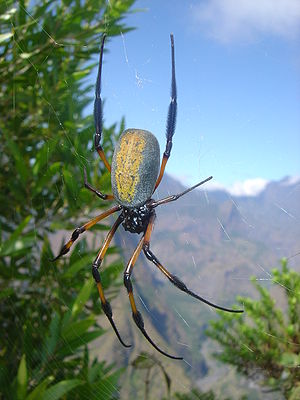Silk spiders (family)
| Silk spiders | ||||||||||||
|---|---|---|---|---|---|---|---|---|---|---|---|---|

Nephila inaurata |
||||||||||||
| Systematics | ||||||||||||
|
||||||||||||
| Scientific name | ||||||||||||
| Nephilinae | ||||||||||||
| Simon , 1894 |
The silk spiders (Nephilinae) are a pantropically distributed subfamily of the real orb web spiders and comprise seven genera .
features
Representatives of the silk spiders are medium-sized to large spiders with a body length of three to 40 millimeters. The male is usually considerably smaller than the female. They have eight eyes that are arranged in two rows of four eyes each. The species in the genus Nephila have an additional light-reflecting layer in their secondary eyes called a tapetum , which makes the eyes appear pale.
In the notch of their strongly developed chelicerae there are two rows of teeth with a few smaller teeth in between. The lateral condyle is slightly fluted. The labium is wider than it is long. The basal segments of the pedipalps , the so-called maxillae , widen towards the front.
The male pedipalps are simply built. The paracymbium , an appendix to the dorsal part of the tarsus, is flat and rectangular. Both the subtegulum and the spherical tegulum (the part of the bulb that houses the vas deferens ) are very pronounced. Connected to this via a membrane is the elongated embolus with a strongly pronounced embolic conductor. Silk spiders are entelegyne spiders. This means that the external female sex organ is the epigyne , so there are two separate vas deferens; one to the spermathecae and one to the uterus . The conductors at the entrance to the partially or completely sclerotized epigyne are short.
The construction of the carapace varies between the genera. The carapace of the genera Nephila and Nephilengys is wide and raised in the head area. In Clitaetra and Herennia, however, it is piriform and flat. In the first three genera, the sternum is shorter than it is wide. Smaller humps on the sternum are found in all four genera. There are three claws on the tarsi of the legs, which are usually covered with a number of bristles. Sustentacula are also often present on the tarsi of the fourth pair of legs . Trichobothria are arranged on the lower legs ( tibia ) .
The variations in the shape of the abdomen (the opisthosoma or abdomen ) are even greater than with the carapace . It appears cylindrical, conical, round, but also elongated, flat and lobed. In males, however, it is always provided with a sclerotized plate (scutum).
For breathing, the representatives of the silk spiders have two book lungs and a tracheal system with an opening near the spinneret .
Way of life
Silk spiders can find their way around in a variety of habitats and are known for their sometimes very large wheel nets , which are provided with an auxiliary spiral .
Systematics
The silk spiders were traditionally mostly classified as a separate family. The group was found to be likely monophyletic based on both morphological and genetic data . and as a sister group of the Araneidae i. e. S. (whereby some of the traditional genres had to be split up). Nevertheless, in the more recent editions it is preferred to regard them as a subfamily of the Araneidae. In a current paper, however, Matjaž Kuntner and colleagues suggest upgrading them back to their own family.
The World Spider Catalog currently lists 7 genera with 42 species for silk spiders
- Clitaetra Simon , 1889
- Herennia Thorell , 1877
- Indoetra Kuntner et al., 2019
-
Nephila Leach , 1815
- Nephila pilipes ( Fabricius , 1793)
- Nephilingis Kuntner et al., 2013
- Nephilengys L. Koch , 1872
-
Trichonephila Kuntner et al., 2019
- Trichonephila clavata L. Koch , 1878 ( syn.Nephila clavata )
- Trichonephila clavipes ( Linnaeus , 1767) ( syn.Nephila clavipes )
- Trichonephila komaci Kuntner & Coddington , 2009 ( syn.Nephila komaci )
Web links
literature
- Rudy Jocqué, Ansie Dippenaar-Schoeman: Spider Families of the World . Ed .: Royal Museum for Central Africa. Tervuren 2007, ISBN 90-75894-85-6 , pp. 336 (English).
Individual evidence
- ↑ a b Family: Araneidae Clerck, 1757 . World Spider Catalog (version 20.5). accessed on October 2, 2019. doi: 10.24436 / 2
- ^ Matjaž Kuntner, Miquel A. Arnedo, Peter Trontelj, Tjaša Lokovšek, Ingi Agnarsson (2013): A molecular phylogeny of nephilid spiders: Evolutionary history of a model lineage. Molecular Phylogenetics and Evolution 69: 961-979. doi: 10.1016 / j.ympev.2013.06.008
- ^ Ward C. Wheeler, Jonathan A. Coddington, Louise M. Crowley, Dimitar Dimitrov, Pablo A. Goloboff, Charles E. Griswold, Gustavo Hormiga, Lorenzo Prendini, Martín J. Ramírez, Petra Sierwald, Lina Almeida ‐ Silva, Fernando Alvarez ‐Padilla, Miquel A. Arnedo, Ligia R. Benavides Silva, Suresh P. Benjamin, Jason E. Bond, Cristian J. Grismado, Emile Hasan, Marshal Hedin, Matías A. Izquierdo, Facundo M. Labarque, Joel Ledford, Lara Lopardo , Wayne P. Maddison, Jeremy A. Miller, Luis N. Piacentini, Norman I. Platnick, Daniele Polotow, Diana Silva ‐ Dávila, Nikolaj Scharff, Tamás Szűts, Darrell Ubick, Cor J. Vink, Hannah M. Wood, Junxia Zhang (2016): The spider tree of life: phylogeny of Araneae based on target ‐ gene analyzes from an extensive taxon sampling. Cladistics 33 (6): 574-616. doi: 10.1111 / cla.12182
- ↑ Dimitar Dimitrov, Ligia R. Benavides, Miquel A. Arnedo, Gonzalo Giribet, Charles E. Griswold, Nikolaj Scharff, Gustavo Hormiga (2017): Rounding up the usual suspects: a standard target-gene approach for resolving the interfamilial phylogenetic relationships of ecribellate orb-weaving spiders with a new family-rank classification (Araneae, Araneoidea). Cladistics 33: 221-250. doi: 10.1111 / cla.12165
- ↑ Matjaž Kuntner, Chris A Hamilton, Ren-Chung Cheng, Matjaž Gregorič, Nik Lupše, Tjaša Lokovšek, Emily Moriarty Lemmon, Alan R Lemmon, Ingi Agnarsson, Jonathan A Coddington, Jason E. Bond (2019): Golden Orbweavers Ignore Biological Rules : Phylogenomic and Comparative Analyzes Unravel a Complex Evolution of Sexual Size Dimorphism. Systematic Biology 68 (4): 555-572 doi: 10.1093 / sysbio / syy082 (open access)